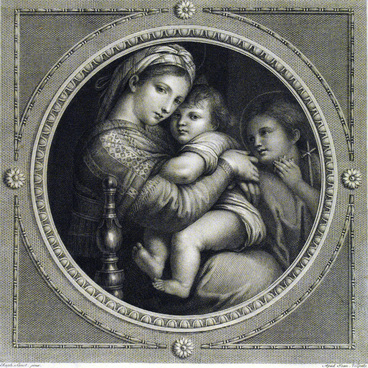Charles-Nicolas Cochin the Elder is a French engraver, draftsman, designer, and illustrator. Born into a family of a painter Charles Cochin, he practiced painting in line with the family until the age of 22 and then devoted himself to engraving. In 1729, Cochin for the first time presented his artworks to the Academy of Painting and Sculpture and soon after, in 1731, was granted Academy membership. He engraved the portrait of the Academy founder Jacques Sarrazin and painter Eustache Le Sueur, one of the Academy patriarchs. Cochin was a court painter to the French king Louis XIV. In the last years of his life he worked primarily at the studio and print shop of his son Charles-Nicolas Cochin the Younger (1715—1790) under whose management their company developed into a Europe’s major producer of quality prints. The artist died in 1754 in Paris in his own apartment located in Louvre.
The Grove of Bacchus displayed here is a French print of the Rococo age. The Rococo style is generally known as the “gallant style” and its flourishing time as “gallant age”. In painting, the gallant ideal found its brightest embodiment in the works of Antoine Watteau, and it is his painting that Cochin the Elder used to make the engraving of.
The so-called Recueil Jullienne (Julienne’s Compendium), a corpus of engravings after Antoine Watteau, was published in 1734 by his close friend and collector Jean de Julienne. The publication is distinguished by a new approach to the etching technique used: a combination of various etching methods with the cutting tool enabled the engravers to bring out the texture of the originals in a superb masterful fashion. The two first volumes of the Julienne’s Compendium contain prints after the drawings of Antoine Watteau. The third volume published in the 1730s was fully devoted to the artist’s paintings.
The Grove of Bacchus displayed here is a French print of the Rococo age. The Rococo style is generally known as the “gallant style” and its flourishing time as “gallant age”. In painting, the gallant ideal found its brightest embodiment in the works of Antoine Watteau, and it is his painting that Cochin the Elder used to make the engraving of.
The so-called Recueil Jullienne (Julienne’s Compendium), a corpus of engravings after Antoine Watteau, was published in 1734 by his close friend and collector Jean de Julienne. The publication is distinguished by a new approach to the etching technique used: a combination of various etching methods with the cutting tool enabled the engravers to bring out the texture of the originals in a superb masterful fashion. The two first volumes of the Julienne’s Compendium contain prints after the drawings of Antoine Watteau. The third volume published in the 1730s was fully devoted to the artist’s paintings.
The Grove of Bacchus pained by Watteau sometime between 1715 and 1718 was reproduced in the mirror image engraving. A number of elements and sketches for that work could be linked to the Autumn composition from the Four Seasons series (for instance, the Bacchus sitting with the cup in his hands). The composition contains about twenty figures with merely seven of them shown in the foreground apparently qualifying for main characters. Sketches for them are kept in US and European museums and private collections. The central group of figures is similar to that shown in The Gathering near the Fountain of Neptune held in the Prado Museum, Madrid. The print was accepted by the Museum in 1919 from the Baryatino Estate of Tarusa Region in Kaluga Province, as part of a private art collection owned by the Prince Gorchakov’s family.


